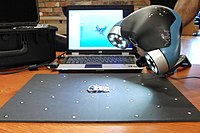
Photo from wikipedia
Images of the kidneys using dynamic contrast-enhanced magnetic resonance renography (DCE-MRR) contains unwanted complex organ motion due to respiration. This gives rise to motion artefacts that hinder the clinical assessment… Click to show full abstract
Images of the kidneys using dynamic contrast-enhanced magnetic resonance renography (DCE-MRR) contains unwanted complex organ motion due to respiration. This gives rise to motion artefacts that hinder the clinical assessment of kidney function. However, due to the rapid change in contrast agent within the DCE-MR image sequence, commonly used intensity-based image registration techniques are likely to fail. While semi-automated approaches involving human experts are a possible alternative, they pose significant drawbacks including inter-observer variability, and the bottleneck introduced through manual inspection of the multiplicity of images produced during a DCE-MRR study. To address this issue, we present a novel automated, registration-free movement correction approach based on windowed and reconstruction variants of dynamic mode decomposition (WR-DMD). Our proposed method is validated on ten different healthy volunteers’ kidney DCE-MRI data sets. The results, using block-matching-block evaluation on the image sequence produced by WR-DMD, show the elimination of $$99\%$$99% of mean motion magnitude when compared to the original data sets, thereby demonstrating the viability of automatic movement correction using WR-DMD.
Journal Title: Machine Vision and Applications
Year Published: 2017
Link to full text (if available)
Share on Social Media: Sign Up to like & get
recommendations!